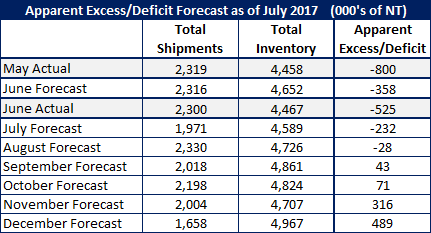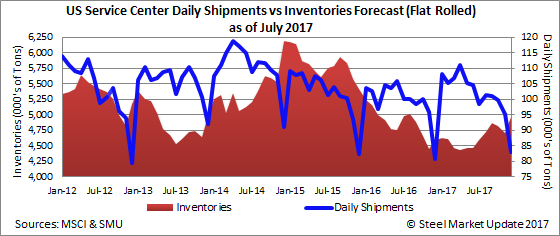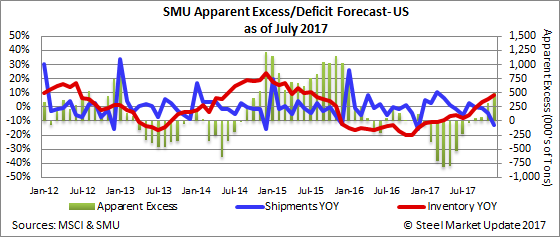SMU Data and Models

Service Center Flat Rolled Apparent Inventory Deficit Shrinks
Written by John Packard
July 19, 2017
After a careful analysis of the Metals Service Center Institute (MSCI) carbon flat rolled shipment and inventories data, and then applying that data to our proprietary Apparent Excess/Deficit inventories model, we have determined that distributor inventories improved during the month of June.
At the end of May, based on the MSCI data, SMU calculates that service centers had an 800,000-ton carbon flat rolled inventories deficit. Looking at the data just released for the month of June, the deficit continues, but it has dropped to -525,000 tons.
Looking at our original forecast for the month of June, we forecast shipments of 2,316,000 tons. We were very close as shipments came in at 2,300,000 tons.
At the same time, we forecast inventories of carbon flat rolled to be 4,652,000 tons at the end of June. Inventories, according to the MSCI, were 4,467,000 tons.
Our original forecast was for the Apparent Deficit to drop to -358,000 tons. We got the direction correct, but we were slightly too optimistic.
SMU Forecast for July 2017
We are continuing to use the same formula. Using a three-year average month-to-month change, our forecast calls for a continued drop in the Apparent Deficit. We anticipate that it will drop to -232,000 tons by the end of July. As you can see by the table below, we are forecasting shipments of 1,971,000 tons and end-of-July inventories to be 4,589,00 tons. We believe service centers will continue to grow their inventories through the end of the year.

John Packard
Read more from John PackardLatest in SMU Data and Models

SMU Scrap Survey: Sentiment Indices rise
Both current and future scrap sentiment jumped this month, though survey participants reported responses before key trade news was announced.

SMU Survey: Sentiment splits, buyers have better view of future than the present
SMU’s Steel Buyers’ Sentiment Indices moved in opposite directions this week. After rebounding from a near five-year low in late June, Current Sentiment slipped again. At the same time, Future Sentiment climbed to a four-month high. Both indices continue to show optimism among buyers about their company’s chances for success, but suggest there is less confidence in that optimism than earlier in the year.

SMU scrap market survey results now available
SMU’s ferrous scrap market survey results are now available on our website to all premium members. After logging in at steelmarketupdate.com, visit the pricing and analysis tab and look under the “survey results” section for “ferrous scrap survey” results. Past scrap survey results are also available under that selection. If you need help accessing the survey results […]

SMU flat-rolled market survey results now available
SMU’s latest steel buyers market survey results are now available on our website to all premium members. After logging in at steelmarketupdate.com, visit the pricing and analysis tab and look under the “survey results” section for “latest survey results.” Past survey results are also available under that selection. If you need help accessing the survey results, or if […]

SMU Survey: Sheet lead times stabilize, plate contracts
Mill lead times for sheet products were steady to slightly longer this week compared to our late June market check, while plate lead times contracted, according to steel buyers responding to this week’s market survey.



